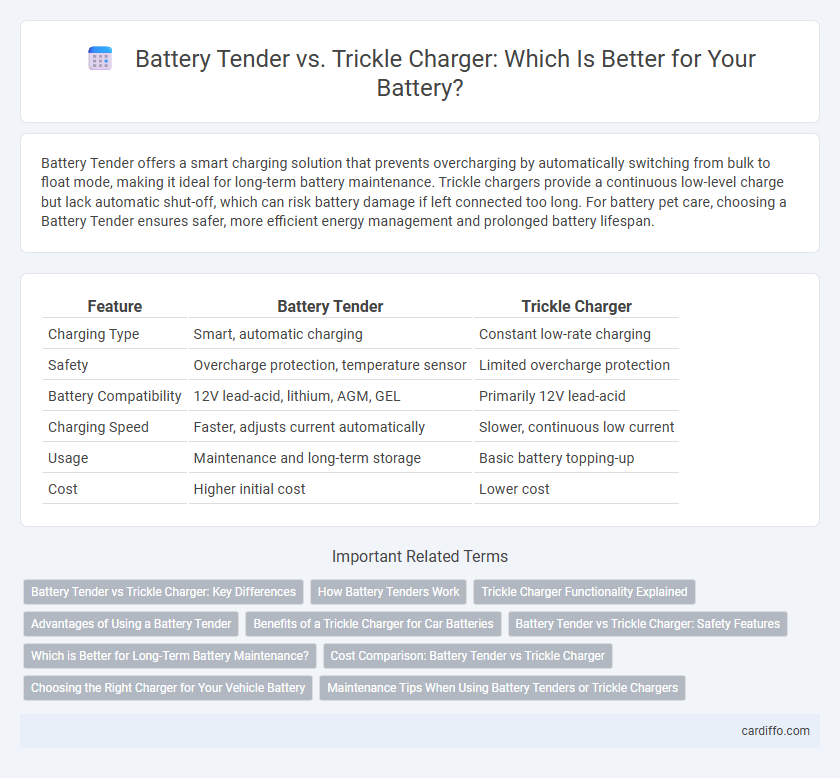Battery Tender offers a smart charging solution that prevents overcharging by automatically switching from bulk to float mode, making it ideal for long-term battery maintenance. Trickle chargers provide a continuous low-level charge but lack automatic shut-off, which can risk battery damage if left connected too long. For battery pet care, choosing a Battery Tender ensures safer, more efficient energy management and prolonged battery lifespan.
Table of Comparison
| Feature | Battery Tender | Trickle Charger |
|---|---|---|
| Charging Type | Smart, automatic charging | Constant low-rate charging |
| Safety | Overcharge protection, temperature sensor | Limited overcharge protection |
| Battery Compatibility | 12V lead-acid, lithium, AGM, GEL | Primarily 12V lead-acid |
| Charging Speed | Faster, adjusts current automatically | Slower, continuous low current |
| Usage | Maintenance and long-term storage | Basic battery topping-up |
| Cost | Higher initial cost | Lower cost |
Battery Tender vs Trickle Charger: Key Differences
Battery tenders feature advanced microprocessor technology that maintains optimal battery voltage by switching between bulk, absorption, and float modes, preventing overcharging. Trickle chargers provide a constant low-level charge, which can lead to battery damage if left connected too long. Battery tenders are ideal for long-term maintenance, while trickle chargers are better suited for short-term slow charging.
How Battery Tenders Work
Battery tenders maintain optimal battery voltage by delivering a controlled, low amperage charge that prevents overcharging and extends battery life. They continuously monitor battery voltage and automatically switch between bulk charging, absorption, and float modes to ensure the battery stays fully charged without damage. This intelligent charging process is ideal for long-term storage of automotive, motorcycle, and marine batteries.
Trickle Charger Functionality Explained
A trickle charger maintains a battery's charge by providing a low, steady flow of electricity to counteract self-discharge without overcharging. It is ideal for long-term battery maintenance in vehicles, ensuring batteries remain fully charged and ready for use. Unlike higher-output chargers, trickle chargers protect battery life by delivering a consistent, gentle voltage tailored to prevent damage.
Advantages of Using a Battery Tender
A Battery Tender offers precise voltage regulation and automatic shutoff, preventing overcharging and prolonging battery life significantly. Its advanced microprocessor technology monitors battery status in real-time, ensuring optimal charge maintenance compared to basic trickle chargers. This efficiency reduces the risk of acid buildup and corrosion, making Battery Tenders ideal for long-term battery health and reliability.
Benefits of a Trickle Charger for Car Batteries
A trickle charger maintains a car battery's full charge by delivering a low, steady current that prevents overcharging and extends battery lifespan. It is ideal for vehicles stored for long periods, as it combats self-discharge without damaging battery cells. Using a trickle charger helps ensure reliable engine starts and reduces the need for battery replacements.
Battery Tender vs Trickle Charger: Safety Features
Battery Tender devices incorporate advanced safety features such as automatic shutoff, reverse polarity protection, and temperature compensation to prevent overcharging and potential battery damage. Trickle chargers often lack these sophisticated mechanisms, increasing the risk of overheating or sulfur buildup when left connected for extended periods. Choosing a Battery Tender ensures enhanced safety and extends battery lifespan through smart charging technology.
Which is Better for Long-Term Battery Maintenance?
Battery Tender offers smart charging technology with automatic voltage regulation, preventing overcharging and extending battery life, making it ideal for long-term maintenance. Trickle chargers provide a continuous low current that can risk battery damage if not monitored, reducing their suitability for prolonged use. For optimal longevity, Battery Tenders are preferred due to safer, maintenance-friendly charging cycles.
Cost Comparison: Battery Tender vs Trickle Charger
Battery Tender devices typically cost between $50 and $80, offering advanced microprocessor control for efficient charging and battery maintenance. Trickle chargers are generally more affordable, ranging from $20 to $50, but lack automatic shut-off features, which can risk overcharging and battery damage. Choosing between Battery Tender and trickle charger depends on balancing initial cost with long-term battery health and safety benefits.
Choosing the Right Charger for Your Vehicle Battery
Battery Tender chargers provide smart charging with automatic voltage regulation, preventing overcharging and extending battery life, making them ideal for modern vehicle batteries including motorcycles, cars, and boats. Trickle chargers deliver a constant low amperage charge that maintains battery voltage but require careful monitoring to avoid battery damage, suitable for occasional use or older batteries. Selecting the right charger depends on your vehicle type, battery capacity, and whether you need maintenance charging or fast charging capabilities.
Maintenance Tips When Using Battery Tenders or Trickle Chargers
When maintaining batteries with Battery Tenders or trickle chargers, ensure the charger is compatible with your battery type to prevent overcharging or damage. Regularly inspect charging cables and connections for corrosion or wear, and keep the battery terminals clean and tight. Monitoring the battery's charge level periodically helps optimize performance and prolong battery life during extended storage periods.
Battery Tender vs Trickle Charger Infographic

 cardiffo.com
cardiffo.com